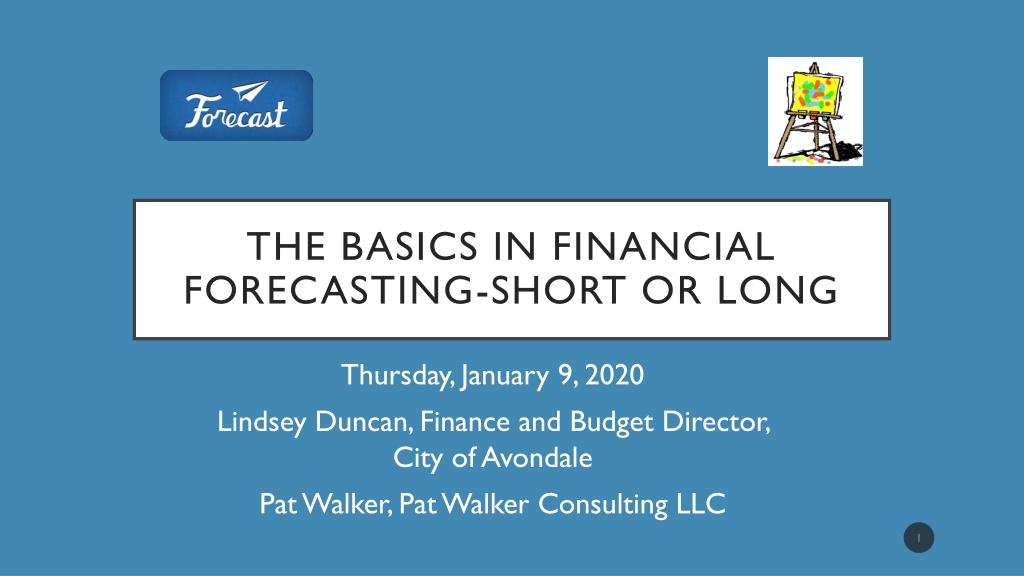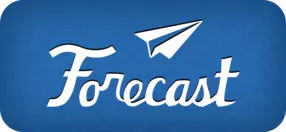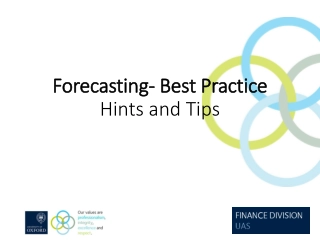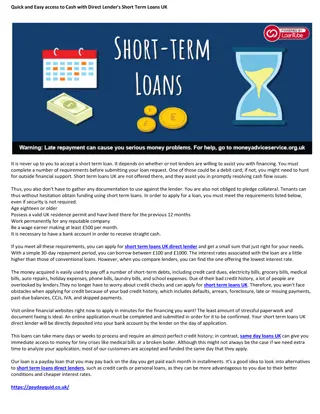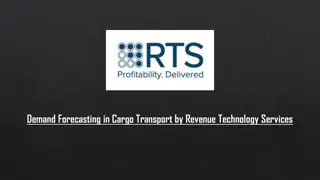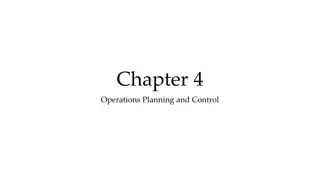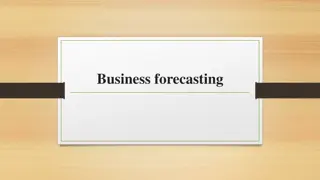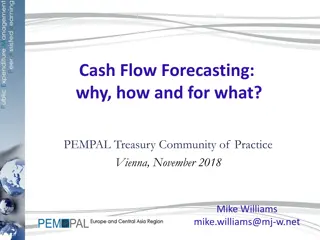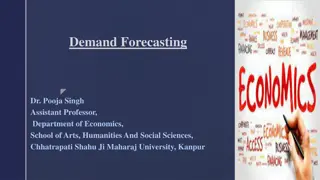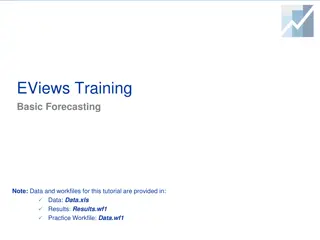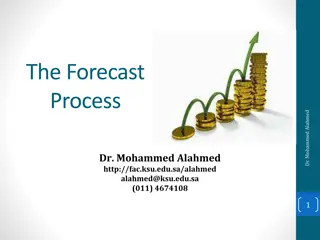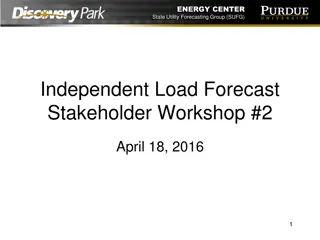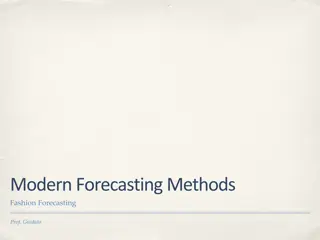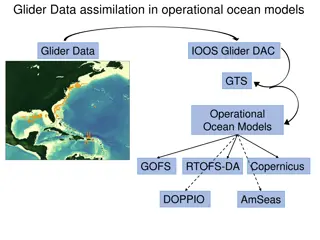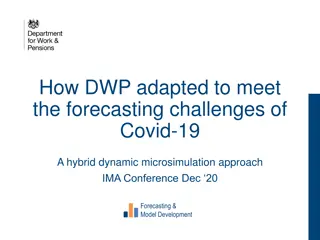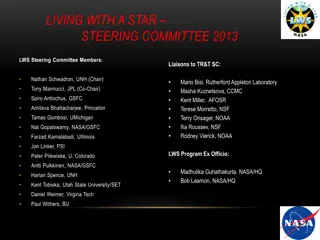Financial Forecasting: Short vs Long Term Strategies
Explore the differences between short and long-term financial forecasting in this informative presentation. Understand the importance of accurate forecasting for guiding policy decisions, strategic planning, and maintaining fiscal discipline. Learn about forecasting methodologies, managing expenditures, and projecting revenues to optimize financial planning processes.
Uploaded on Sep 11, 2024 | 1 Views
Download Presentation

Please find below an Image/Link to download the presentation.
The content on the website is provided AS IS for your information and personal use only. It may not be sold, licensed, or shared on other websites without obtaining consent from the author.If you encounter any issues during the download, it is possible that the publisher has removed the file from their server.
You are allowed to download the files provided on this website for personal or commercial use, subject to the condition that they are used lawfully. All files are the property of their respective owners.
The content on the website is provided AS IS for your information and personal use only. It may not be sold, licensed, or shared on other websites without obtaining consent from the author.
E N D
Presentation Transcript
THE BASICS IN FINANCIAL FORECASTING-SHORT OR LONG Thursday, January 9, 2020 Lindsey Duncan, Finance and Budget Director, City of Avondale Pat Walker, Pat Walker Consulting LLC 1
PRESENTATION OBJECTIVES Introduction/Overview Overview of Budget Process Short vs Long Term Forecasting Forecasting Methodologies Forecasting Expenditures Nuts & Bolts of Forecasting Revenues Questions/Discussion 2
Project out your revenues Expenses-One time versus on-going BUDGET PROCESS Fund balances
NEVER ENDING CYCLE Preparation Audit Adoption Evaluation Implementation
FORECASTING IS VERY DIFFICULT, ESPECIALLY IF IT IS ABOUT THE FUTURE NIELS BOHR, NOBEL PRIZE-WINNING PHYSICIST 5
PURPOSE OF FORECASTING Evaluate current and future fiscal conditions to guide policy and programmatic decisions Fiscal management tool to provide financial estimates based on past, current and projected financial conditions Allows for improved decision making to maintain fiscal discipline Integral part of budget process 6
SHORT TERM VS LONG TERM FORECASTS Longer the period estimate, the lower the accuracy Unexpected events can occur such as recessions, inflation, regulation or deregulation, law changes, relocation of major employer or natural disaster Estimates out past 3 years may so far off and mislead public policy choices Credibility issues if forecasts are way off from actuals If long range forecasts are heeded to and actions are taken and then it is wrong, another credibility issue 7
SHORT TERM VS LONG TERM FORECASTS Positive side is that long term forecasts are needed for strategic financial planning Proactive steps can be taken to solve budgetary issues Short term is usually considered 3 years or less Depending on forecasting tools used, should be more accurate than long term Can be more easily explained and defended Can be combined with long term forecasts 8
FINANCIAL FORECASTING Have to know how much you can spend without anything changing baseline Financial forecasting is one of the Finance Director s most important tasks Allows a proactive versus reactive response to potential imbalances Long term plans & strategies 9
REVENUE FORECASTING 10
Must understand revenue source Historical data must be clean Incorrect posting of revenues Law changes Inconsistency Revenue Fluctuations KEY TO REVENUE FORECASTING Open and transparent process No one methodology fits all revenues forecasted 11
Forecaster must understand the revenue being forecast, how it is administered and collected Estimates based on incorrect, misunderstood or inconsistent revenue data is hopeless! Visually see revenue collections with a simple line graph over time Open and transparent process with one ultimate revenue projection No single approach is ideally suited for all revenue forecasts GUIDE FOR REVENUE FORECASTING 12
Each revenue source responds to different factors and should be separately forecasted Revenue collections must be monitored regularly against budget projections GUIDE FOR REVENUE FORECASTING Some will be up, some will be down but keep below 3-5% of overall of projections or adjustments need to be made mid-year Prior year months, quarters and annuals must be analyzed for better estimates 13
Look for methods that produce a satisfactory forecast for the current situation METHODS FOR FORECASTING Simple time series or regression against time No economic, demographic, social or cultural variables are used i.e. $5,000 increase or past 5 years, then $5,000 for next year Only past revenue data is used i.e. X% for past 5 years, then X% for next year. Short term forecast 14
Simple time or regression against time cont d i.e. use average of past collections that have the least amount of variances METHODS FOR FORECASTING Deterministic Modeling Used for long term forecasting Links GDP, personal income or other economic indicator Used when revenue is new and insufficient data available Not good when unstable economy 15
Multiple Regression Popular forecasting model Forecasts revenue as a function of one or more independent variables Each revenue source variable is independent of others METHODS FOR FORECASTING Econometric modeling Models can be expensive Used for larger more complicated local economies Used for revenue sources that are impacted by various factors such as per capita income, inflation, population changes, etc. 16
Judgmental and Experience Forecasting Usually by seasoned long term Finance and Budget Directors Knows the community inside and out Works with other departments in gathering data from them for current and future revenue estimates Can use it with other methodologies discussed METHODS FOR FORECASTING 17
MOST WIDELY USED FORECAST Judgmental and Subjective! Devastatingly accurate and immensely useful 18
TYPE OF REVENUE FORECAST Forecast research has found Statistically sophisticated or complex methods do not necessarily produce more accurate forecasts than simpler ones. * Whatever type you use, it should be easy to understand, transparent and structured. *Government Finance Review, Revenue Forecasting, October 2012.
Two policies but Council must understand differences in policies Conservative Under estimating revenues but if TOO conservative could lead to unnecessary fiscal stress, loss of opportunity costs or layoffs Objective Project revenues as accurate as possible but understand risks. Could result in budget cuts/layoffs Must have contingency funds and strong financial policies FORECAST POLICIES 20
EXPENDITURE FORECASTING 21
Guidelines for departments to prepare their budget Council goals Spending priorities Can set targets for spending Examples of guidelines: Inflationary factors to be used for operating and capital expenditures New laws or mandates requirements Population projections for the next year Public Safety is a council priority Lease or buy BUDGET GUIDELINES 22
DEPARTMENTAL EXPENDITURES Must determine budget process to be used such as: Zero based Target based Performance Program Incremental Line item 23
Personnel costs are largest portion of operating budget Consider salary increases, insurance increases (medical and workman s comp), retirement contributions, social security & overtime DEPARTMENTAL EXPENDITURES What are one-time versus on-going expenditures? Can use CPI overall, or evaluate each line item to consider increases in fuel, utilities, etc. 24
THE NUTS AND BOLTS OF REVENUE FORECASTING
City Manager: Did you include the new forecast in your THE NEW FILL-IN- THE- BLANK Restaurant Hotel Movie theater Big box retail store
DONT: Add new sales tax generating establishments twice DO: Develop EITHER a trend based forecast OR a per establishment forecast
THE CONSTRUCTION SALES TAX TRAP How do you forecast? How much of the construction sales tax (contracting transaction privilege tax) is Ongoing? One-time? How do you use?
Construction Sales Tax History $30.0 $25.0 $20.0 Millions $15.0 $10.0 $5.0 $-
City Court: Photo radar will create an unprecedented increase in our staff caseload. [Look how busy we are, we need more staff!] THE SKY IS FALLING! Budget Office: How many cases and what is the fee? [This would be $1M in revenue, we will be conservative and say $900K]
THE REALITY FY2011 BUDGET FY2013 BUDGET - $600K + $900K
DONT: Rely on department workload concerns DO: Critically evaluate new programs, Wait for results and adjust mid-year Similar sources: passports
THE WHOLE IS LESS THAN THE SUM OF ITS PARTS Home Builder A 200 permits Home Builder A B C D Total Permits 200 400 300 200 1,100 Home Builder D 200 permits Home Builder B 400 permits Home Builder C 300 permits 10-year permit average: 500
DONT: Rely on private sector forecasts all homebuilders think they will win: sell all of the city s forecasted permits DO: Conduct Reasonableness test based on historical trends
THE HEADLINE TEST Community and Recreation Services Director: I never want to be in the paper for having missed my revenue forecast. This Photo by Unknown Author is licensed under CC BY-SA
Recreation Revenue $6.0 $5.0 $4.0 Millions $3.0 $2.0 $1.0 $- FY2012 FY2013 FY2014 FY2015 FY2016 FY2017 FY2018 FY2019 Adopted Estimate Actual
RECREATION REVENUE HISTORY Fiscal Year Adopted Estimated Actual 3.94 3.82 4.49 3.99 3.96 3.96 4.21 4.41 4.08 4.45 4.47 3.99 4.36 4.22 4.33 4.88 4.73 4.72 4.71 4.38 4.83 4.58 4.88 FY2012 FY2013 FY2014 FY2015 FY2016 FY2017 FY2018 FY2019 -
DONT: Be overly conservative: represents a lost opportunity and damages credibility. DO: Conduct Reasonableness test based on historical trends and other known factors.
THE FRAUD CONTROL = $630,000 ? 7,000 BUSINESS LICENSES x $100 PER LICENSE
DONT: Walk away when the factors don t make sense DO: Trust your instincts, investigate further
City Manager: Did you include the new forecast in your THE NEW FILL-IN- THE- BLANK a. Restaurant b. Hotel c. Movie theater d. Big box retail store
THE TAKEAWAYS Forecasting is an art as much as a science Understand if the patterns and anomalies in the data are Trend, Timing, or Other Know how your revenues are recorded and if/when changes are made (accounting and budget) Talk to other people!!!!
QUESTIONS? 43
